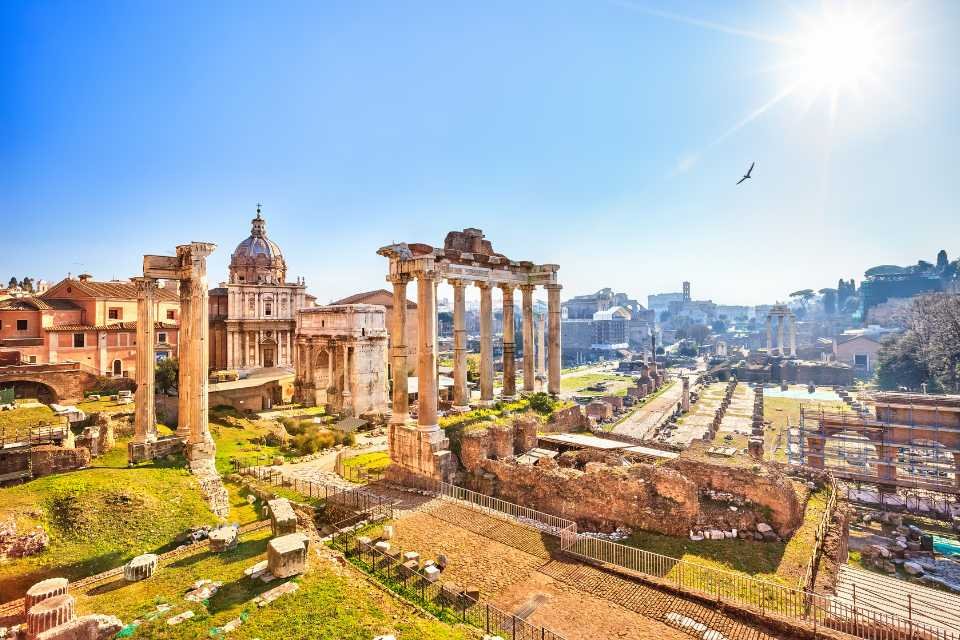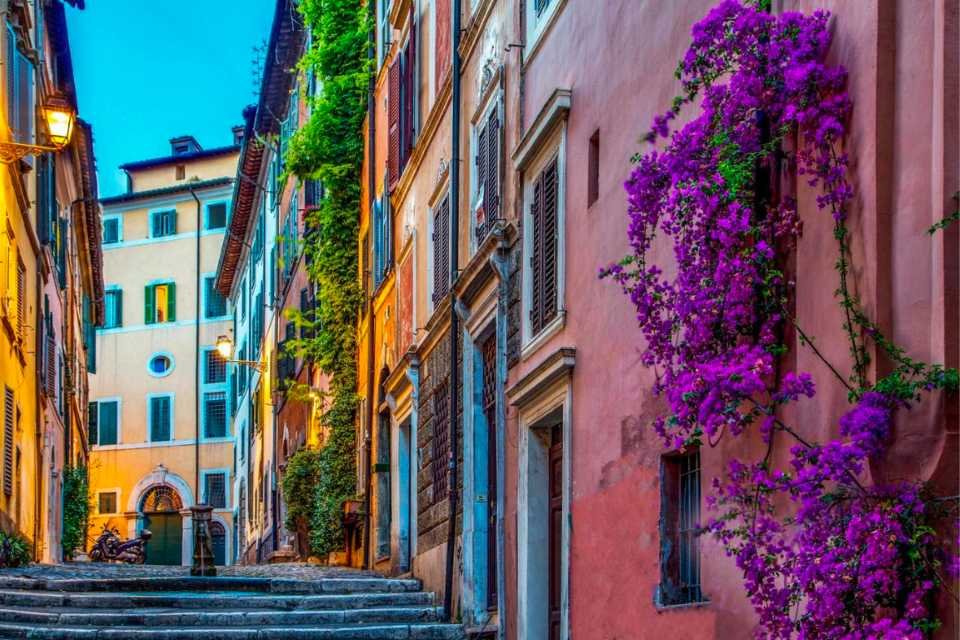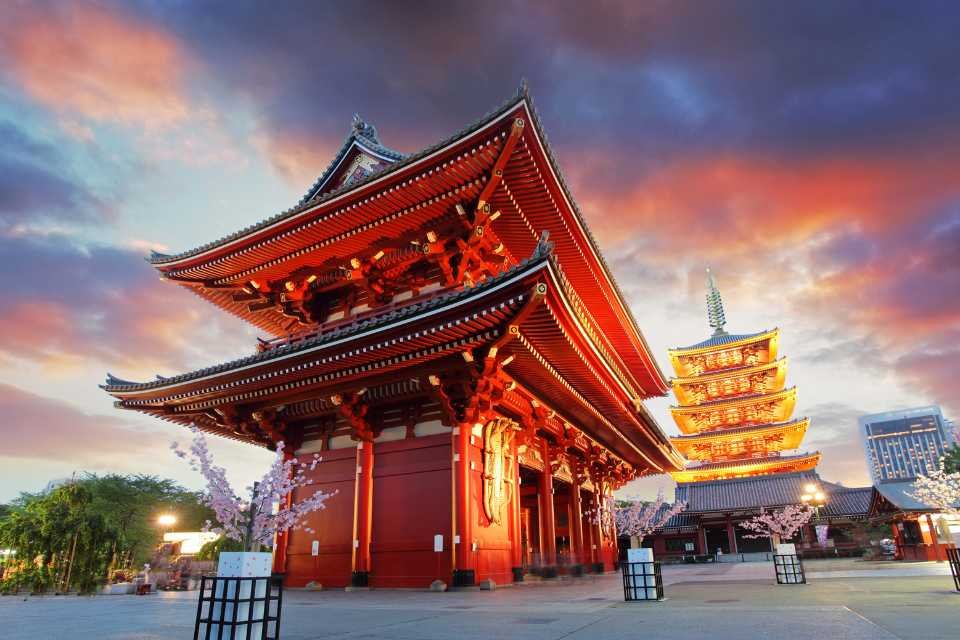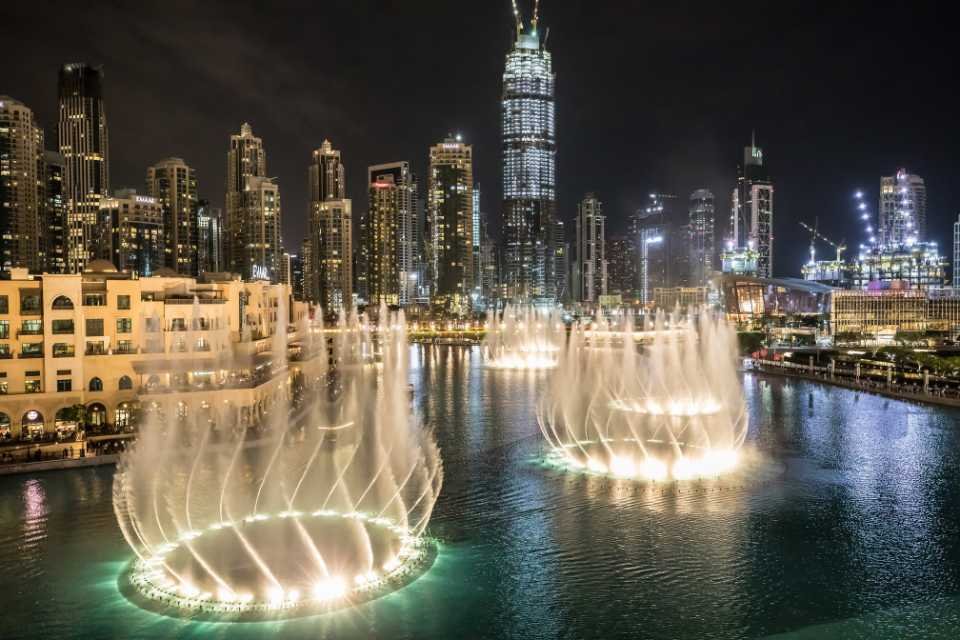Rome’s Roman Forum travel guide
Explore the ruins of ancient Rome’s most important meeting place
It's hard to appreciate the splendour of ancient Rome in these five acres of remains, but they have a symbolic attraction and a lonely drama at certain times of day that make them one of the most captivating sets of ruins anywhere in the world. The Roman Forum was once the centre of the Mediterranean world.
If you can get your brain going, following in the footsteps of great Romans like Julius Caesar and other historical people can be captivating. It's an essential to visit the Arco di Settimio Severo, the Curia, the Temple of Saturn and the Arco di Tito.
About the Roman Forum
Near Capitoline Hill, the forum is a rectangular valley bounded by the Arch of Titus and the Arch of Septimus Severus, both of which are Roman structures. Via dei Fori Imperiali, a broad avenue built by Mussolini in the early 20th century, forms the eastern side.
In the forum, the Via Sacre serves as the main artery. It's the Broadway of Ancient Rome. The paving on the Via Sacre is largely from the time of the Roman Empire.
The forum was in the process of being built. It was Rome's pulsating heart, the seat of power, and the centre of attention. It was a stunning district, with white temples, massive basilicas, and lively public spaces, all of which were appropriate for an empire that ruled half the world.
Roman Forum history
The Roman Forum is one of Rome’s most important archaeological sites, and alongside the Colosseum, a great way to realise the epic scale of ancient Rome.
Events such as trials, elections and gladiatorial combat took place in the Roman Forum every day. Markets and stores lined the narrow alleys and lanes. At the height of Roman rule, the Forum was home to the city's most revered edifices and temples.
With the fall of the Roman Empire, the Forum, like many of Rome's great urban structures, was repurposed as pasture land. Because of its valuable stone and marble, this area was known as the Campo Vaccino (Cow Field) in medieval times. The area was carefully surveyed in the 18th and 19th centuries, and excavations continue until this day.
Roman Forum location entrances
The Arch of Titus near the Colosseum, the Temple of Venus, and Via di San Gregorio are the four main entrances to the Roman Forum, located midway down Via dei Fori Imperiali (via the Palatine).
Opening hours
The site is open every day: 8:30 am until 7 pm and is closed on 25 December and 1 January.
Roman Forum tickets
A SUPER ticket is required to enter the Roman Forum's inside attractions, including the Chiesa di Santa Maria Antiqua, Rampa di Domiziano, and Tempio di Romolo. Admission to the Colosseum and the Roman Forum is included in the two-day ticket. A great way to access both sites and to avoid queues is to buy a tour that includes skip the line tickets.
On the first Sunday of every month, visitors to the Roman Forum are also given free admission to the Colosseum and the Basilica of the Holy Sepulchre.
Roman Forum guided tours
The best way to get great insights from a passionate local expert is with a guided tour of the Roman Forum. We recommended a guided tour because they’ll also guide you through the ruins and tell some stories you won’t hear if you try and explore yourself. They’ll also help you to avoid the crowds and get the most out of your time at the Forum.
Roman Forum buildings and main features
Via Sacra to the Curia
Via Sacra, one of Rome's most famous streets, is easy to recognise, as is the Capitoline Temple of Juno, where emperors and generals would ride in procession to pay their respects to Juno, the goddess of war, after their victories. The Curia, the Senate's meeting place on Capitoline Hill, was built on Julius Caesar's orders as part of his Forum enlargement programme, however what you see now is a reconstruction from the third century AD. Around three hundred senators can be accommodated on the three wide staircases that run left and right inside the Capitol.
Chiesa di Santa Maria Antiqua
Chiesa di Santa Maria Antiqua, the forum's oldest and most important Christian site, is located just a few blocks away. Its vast interior, which reopened in 2016 after a protracted renovation, is a treasure trove of early Christian art, with stunning murals from the sixth to ninth centuries and a hanging representation of the Virgin Mary with child, one of the earliest icons in existence.
Arch of Septimius Severus
The Arch of Septimius Severus near the Curia was erected in remembrance of the conquests in Iran in the early third century AD. The low brown wall next to the arch is the Rostra, from which important speeches were delivered (it was most likely from here that Mark Anthony spoke about Caesar after his death), to the left of which are the long stairs of the Basilica Julia, built by Julius Caesar in the 50s BC after his return from the Gallic wars.
Rails mark the site of the Lacus Curtius, where, history has it, a chasm emerged during the early days of the city and the soothsayers determined that it would only be closed if Rome had sacrificed its most prized treasure into it. When Marcus Curtius said that a loyal citizen was Rome's most valuable asset, he and his horse jumped into the void.
Basilica Guilia & Tempio di Castore e Polluce
The stubby remnants of the Basilica Giulia, begun by Julius Caesar and completed by Augustus, can be found on the southern side of Piazza del Foro. Three columns from the 5th-century BCE Tempio di Castore e Polluce survive at the basilica's far end.
The Basilica of Maxentius and the Arch of Titus
Almost opposite the House of the Vestal Virgins, a shaded walkway to the left leads to the Basilica of Maxentius, the Forum's most magnificent surviving structure in terms of scale and creativity.
It was started by Maxentius and maintained by his co-emperor and adversary, Constantine, after he defeated him at the Battle of the Milvian Bridge in 312 AD. The Via Sacra ascends more steeply from here to the Arch of Titus, which was constructed by Titus's brother, Domitian, after the emperor's death in 81 AD, to celebrate his victory in Judea in 70 AD and triumphal return from that campaign.
Where to eat near the Roman Forum
Trattoria Luzzi
Trattoria Luzzi is one of the most popular restaurants near the Colosseum in Rome, and it is only a few blocks away. With check tablecloths, English language menus, and an earlier supper opening time, this is a more tourist-friendly restaurant.
La Taverna dei Quaranta
La Taverna Dei Quaranta has been serving traditional Italian cuisine since 1982 and is only a five-minute walk from the Colosseum. Despite its location in a busy tourist region, this restaurant caters to locals. There are no surprises on this menu, but there is always a nice selection on the specials board.
Urbana 47
Urbana 47 is a professional chef's favourite restaurant in Rome because of their produce, which is handpicked from small farmers throughout Lazio and committed to cooking with the seasons. The restaurant is tucked away in Rome's chic Cavou neighbourhood and offers a more modern, laid-back ambiance.
Other places to visit around the Roman Forum
Colosseum
Since 80 AD, the Colosseum has been a symbol of Rome, and it is now a top landmark in Italy. The amphitheater's tiered seating once held 50,000 spectators to witness gladiatorial events, and despite pieces of its original marble facade were stolen over the years to create the likes of St. Peter's Basilica, the Colosseum remains impressively intact 2,000 years later.
Trevi Fountain
The highly elaborate Trevi Fountain (Fontana di Trevi) is possibly the most famous fountain in Rome, if not Italy. The baroque Trevi Fountain, centred on the Greek sea god Oceanus as well as Tritons, seahorses, and other legendary characters, has made cameos on the silver screen and is a popular superstition; throw in a penny and make a wish.
Circus Maximus
The Circus Maximus (Circo Massimo) in Rome was the greatest stadium in the Roman Empire, including a gigantic arena for chariot racing, games, religious festivals, and municipal events. A substantial renovation in 2016 resulted in a spruced-up archaeological complex with arched walkways, historic shops, a newly dug cobblestone road, and the rectangular outline and starting gates of the Circus track.
St. Peter's Basilica
The massive St. Peter's Basilica (Basilica di San Pietro) towers over Vatican City, and its dome can be seen from anywhere in Rome. It is the hub of the Catholic Church and the burial place of several popes, including Pope John Paul II, and was built on the location of St. Peter's crucifixion and over his grave.
The beautifully decorated basilica is Italy's largest church and a museum filled with priceless works of art, including Michelangelo's famous Pietà and Bernini's bronze baldachin.
The best hotels near the Roman Forum
The Inn at the Roman Forum
Located just a few steps from some of Rome's oldest and most valuable ruins, such as the Colosseum and the Roman Forum, this 5 star hotel provides exquisite views of the Campidoglio, Palatin Hill, Roman Forum, and Venice Square.
It's the only luxury apartment in Rome that has Roman ruins inside. A corridor at the entry leads to a Cryptoporticus, an impressive stone gallery with engravings dating back 2,000 years.
Nerva Boutique Hotel
Nerva Boutique Hotel has a dream to fulfil: to provide their visitors with an unforgettable pleasant experience and to make them feel at ease. The boutique hotel philosophy is to provide a truly Italian experience, from the meticulously designed interior of all the rooms to the unique homemade foods for breakfast, and lastly to the extra special 'care' from the workers.
The hotel sits in the heart of Rome's historical centre, between the Colosseum and Piazza Venezia, and directly across from the Imperial Forums.
Monti Palace Hotel
Monti Palace Hotel is a wonderful alternative for rest and renewal for visitors to Rome. Monti Palace Hotel, well-known for its family-friendly environment and accessibility to renowned restaurants and sights, makes it simple to enjoy the best of Rome.
NH Collection Roma Fori Imperiali
When you choose the five-star NH Collection Roma Fori Imperiali, you will be staying near one of Rome's most important archaeological areas. This brand new hotel is located on the outskirts of the famous Imperial Forums complex, and several suites offer amazing views of the ruins.
The hotel is also close to Rome's other important sites, such as the Colosseum and the Vatican, as well as Monti's restaurants and bars and the city's main shopping centres.
Top tips for visiting the Roman Forum
The Palatino and Campidoglio offer excellent views of the ruins
Go early in the morning or late in the afternoon; crowds are at their peak between 11 a.m. and 2 p.m.
It becomes very hot in the summer, and there is little shade, so bring a hat and plenty of water.
Comfy shoes are highly recommended
There are restrooms at the Chiesa di Santa Maria Antiqua
Visit on the first Sunday of the month to access the Colloseum on the same ticket
Consider a guided tour to get insights into the forum’s history














